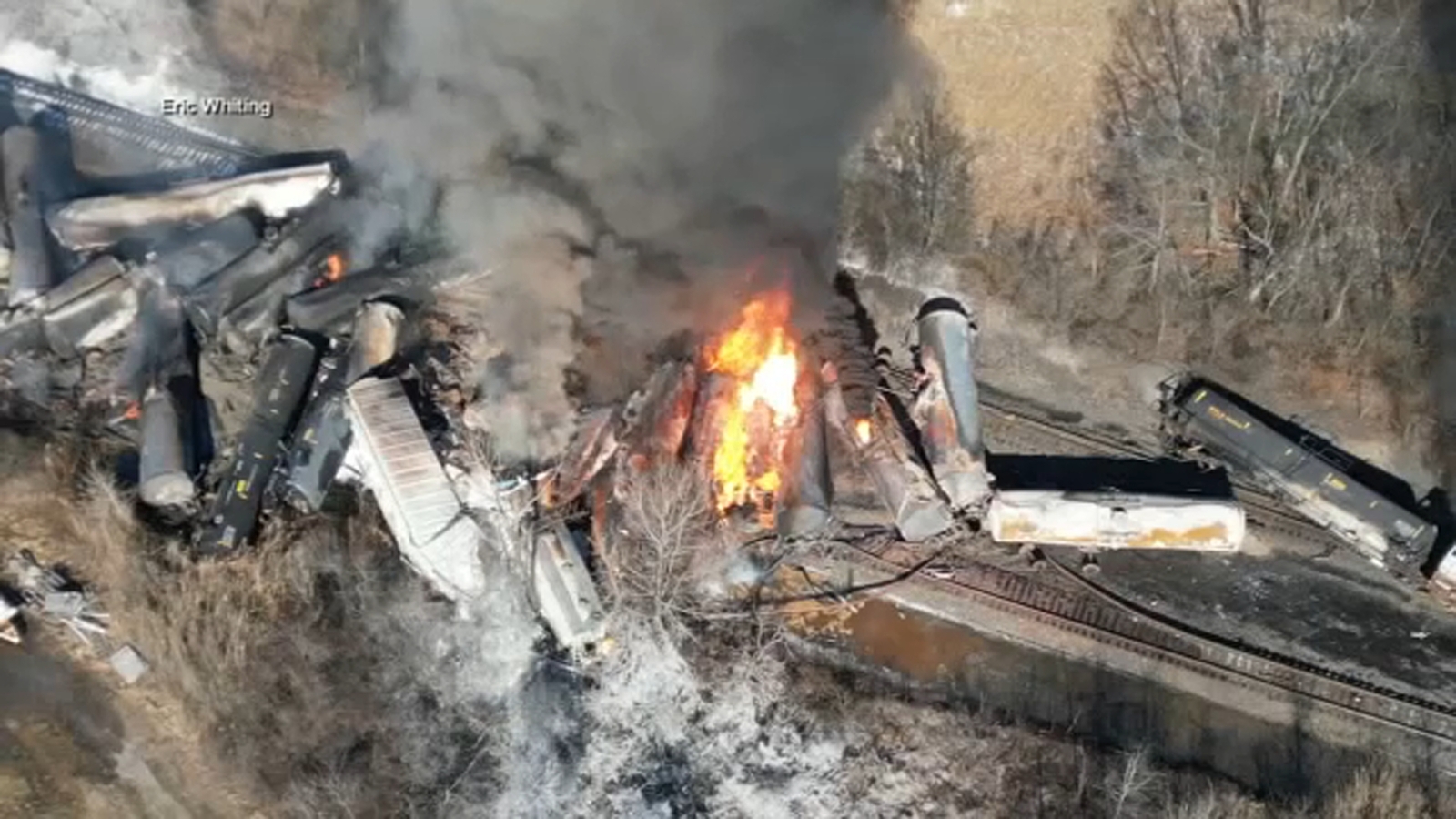The Lingering Threat: Toxic Chemicals In Buildings Months After The Ohio Train Derailment

Table of Contents
Pathways of Chemical Dispersion and Building Contamination
The release of toxic chemicals during the derailment didn't end with the initial incident. These substances continue to pose a threat through various pathways, leading to significant concerns about toxic chemicals in buildings in the affected areas.
Air Dispersion
Airborne pollutants released during the derailment, including vinyl chloride and butyl acrylate, were dispersed by wind patterns, potentially settling on and within buildings.
- Wind patterns: Prevailing winds carried plumes of contaminated air across significant distances.
- Building ventilation systems: These systems can inadvertently draw contaminated air inside, increasing indoor exposure.
- Porous building materials: Materials like wood and brick can absorb airborne chemicals, releasing them slowly over time.
- Impact on indoor air quality: The presence of these chemicals significantly degrades indoor air quality, posing a long-term health risk. The persistence of these volatile organic compounds (VOCs) in indoor environments is a significant concern requiring ongoing monitoring.
Water Contamination
Water contamination represents another crucial pathway for the spread of toxic chemicals in buildings.
- Water infiltration: Runoff from contaminated soil can infiltrate building foundations and plumbing systems.
- Potential for leaching into building materials: Chemicals can leach into building materials, leading to long-term contamination.
- Impact on drinking water sources: Groundwater contamination poses a severe threat to drinking water sources, impacting both building occupants and the wider community. Long-term health effects from ingesting contaminated water are a significant concern.
Soil Contamination
Soil near the derailment site remains heavily contaminated, presenting a persistent risk to nearby buildings.
- Building foundations: Contaminated soil can directly contact building foundations, potentially leading to chemical migration into the structure.
- Porous building materials: Chemicals can seep into porous building materials through soil contact.
- Potential for chemical migration: Chemicals can migrate from the soil into building interiors through cracks in foundations or other pathways.
- Impact on indoor environments: This contamination can impact indoor air and potentially drinking water supplies. Remediation of contaminated soil surrounding buildings is a complex and potentially costly undertaking.
Health Risks Associated with Long-Term Exposure
Long-term exposure to the toxic chemicals in buildings resulting from the derailment poses severe health risks.
Respiratory Issues
Inhalation of these chemicals can lead to various respiratory problems:
- Asthma: Increased incidence and severity of asthma attacks.
- Bronchitis: Inflammation of the bronchial tubes.
- Lung cancer: Increased risk of developing lung cancer.
- Increased susceptibility to respiratory infections: Weakened respiratory systems become more vulnerable to infections. Specific chemicals like vinyl chloride are known carcinogens, posing a significant long-term risk.
Neurological Effects
Exposure to certain chemicals can also result in neurological problems:
- Headaches: Frequent and severe headaches.
- Dizziness: Episodes of dizziness and lightheadedness.
- Cognitive impairment: Difficulties with memory, concentration, and other cognitive functions.
- Neurological disorders: In severe cases, long-term exposure can lead to more serious neurological disorders. Further research is needed to fully understand the long-term neurological effects of this specific chemical mixture.
Other Health Concerns
Beyond respiratory and neurological effects, other health concerns exist:
- Skin irritation: Contact with contaminated surfaces can cause skin rashes, itching, and other irritations.
- Reproductive issues: Some chemicals can affect reproductive health, leading to infertility or birth defects.
- Cancer: Several chemicals released during the derailment are known carcinogens, increasing the risk of various cancers. Comprehensive long-term health monitoring is crucial for those living near the affected areas.
Testing and Remediation Strategies
Addressing the presence of toxic chemicals in buildings requires comprehensive testing and remediation.
Indoor Air Quality Testing
Testing for indoor air quality is critical to assess the extent of contamination:
- Sampling techniques: Various sampling methods exist to collect air samples for analysis.
- Analytical methods: Sophisticated laboratory techniques are used to identify and quantify specific chemicals.
- Interpretation of results: Results need careful interpretation to determine the level of risk and guide remediation efforts. Regular monitoring is necessary to track changes in indoor air quality over time.
Water Testing and Remediation
Testing and remediation of water sources are equally vital:
- Water purification methods: Various methods, such as filtration and disinfection, can be used to remove contaminants.
- Filtration systems: Installing advanced filtration systems in buildings can protect occupants from contaminated water.
- Alternative water sources: In cases of severe contamination, alternative water sources might be necessary. The long-term viability of these sources must be carefully considered.
Soil Remediation
Remediation of contaminated soil around buildings is a complex process:
- Soil excavation: In some cases, contaminated soil must be excavated and removed.
- Bioremediation: Using microorganisms to break down contaminants.
- Chemical stabilization: Using chemicals to immobilize contaminants, preventing further migration. This process requires careful planning and execution to minimize disruption and ensure the effectiveness of remediation.
Conclusion
The persistence of toxic chemicals in buildings months after the Ohio train derailment highlights the need for immediate and comprehensive action. The potential long-term health risks associated with exposure to these chemicals cannot be ignored. Thorough testing for toxic chemicals in buildings is paramount, along with the implementation of effective remediation strategies. Demand thorough testing for toxic chemicals in buildings and support policies that prioritize public health and environmental protection. Further research into the long-term effects of the derailment and the development of effective remediation strategies for toxic chemicals in buildings is crucial to safeguarding the affected communities.

Featured Posts
-
 Becoming A Better Ally A Guide For International Transgender Day Of Visibility
May 10, 2025
Becoming A Better Ally A Guide For International Transgender Day Of Visibility
May 10, 2025 -
 Historic Broad Street Diner Demolition Hyatt Hotel Development
May 10, 2025
Historic Broad Street Diner Demolition Hyatt Hotel Development
May 10, 2025 -
 Makron Starmer Merts I Tusk Proignorirovali Priglashenie V Kiev 9 Maya
May 10, 2025
Makron Starmer Merts I Tusk Proignorirovali Priglashenie V Kiev 9 Maya
May 10, 2025 -
 Elizabeth Line Accessibility Addressing Wheelchair User Gaps
May 10, 2025
Elizabeth Line Accessibility Addressing Wheelchair User Gaps
May 10, 2025 -
 Update Pam Bondi And The Upcoming Release Of Epstein Diddy Jfk And Mlk Files
May 10, 2025
Update Pam Bondi And The Upcoming Release Of Epstein Diddy Jfk And Mlk Files
May 10, 2025
